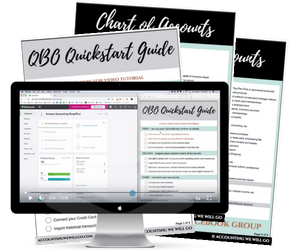Forecasting is a decision-making tool used by many businesses to help with budgeting, planning, and estimating future growth. In the simplest terms, forecasting is the attempt to predict future outcomes based on past events and management insight. (from Investopedia.com)
Forecasting is an important planning tool that allows managers/owners to plan for future performance based on past results. This is especially helpful in e-commerce to plan for inventory investment, owner distribution, and making sure operating expenses are covered.
You cannot prepare reliable forecasts without having your books in order. If you want to start with a firm foundation, enter your information below to download our FREE QBO Quickstart Guide to get you started using QuickBooks Online, including a video tutorial and Chart of Accounts specific to your Amazon business.
NEED HELP WITH YOUR QBO SETUP?
Grab our FREE QBO Quickstart Guide with video tutorial and Chart of Accounts.
Why is forecasting especially difficult for Amazon sellers?
1. The inherent risk of selling on Amazon. Accounts can get suspended with no warning – unfortunately, this is one of the biggest drawback of selling on Amazon. Yes, there are ways to get “unsuspended,” but it’s difficult and expensive. (Some sellers buy business interruption insurance to protect themselves against this happening.)
2. Other sellers can jump on listings resulting in a shared buy box.
3. Amazon can suddenly prohibit the sale of a brand or item.
4. Other sellers may be selling the same item but can get it at a much better price than you, so they can use repricers more aggressively.
5. A supplier you are buying from may run out of stock of your inventory
6. The inherent risk of selling inventory in general. You are taking a risk that what you are selling is going to be purchased by someone at an amount that allows you to pay yourself back, pay Amazon their fulfillment fee, and still allow for profit.
7. Q4 is the "outlier" quarter and it's impossible to estimate sales velocity based on prior months' sales, even if you were selling just one item over and over.
8. You need to estimate with a strong degree of accuracy your operating costs for September, October, November, and December (1/3 of a year.) Out of all of those things, estimating operating costs is probably the easiest to do, but still difficult.
I spoke with e-commerce sellers about the difficulty they have forecasting, and they said considerations are, “warehouse loss is unpredictable, administrative costs related to attempting to find lost inventory, process damages and returns, as well as reimbursements and stranded inventory are going up. Supplier OOS (out of stocks) are a biggie that cannot always be predicted…will you carry your inventory for 60 days or 75 or 90 because it sat at a dock for 14 to 30 days during Q4? Just a few things come to mind.” And, “you also can’t forecast when/if Amazon will raise the fees and/or change the rules. Look what happened to the booksellers.”
Another seller expressed this concern, “Changes to Amazon policies, access to replenishable inventory sources, market trends, federal trade policies, health (personal/immediate family member health crisis,) unexpected financial crisis, inventory impacted by seasonality, the list goes on and on.”
In addition, when a seller has a private label item, it is difficult to estimate the appropriate spend on “PPC” (pay per click.) I have seen numerous products sell well, only for margins to become eroded by overspending on PPC. It makes me wonder if the item was a poor choice and wouldn’t have sold without PPC or the PPC was mismanaged. It’s probably a bit of both.
What can be forecasted?
Despite the difficulty in forecasting, there are some expenditures that CAN be forecasted which are operating costs. Ebay and Amazon sellers should consider this. Operating costs are the expenses associated with the ongoing operations of the business. These include rent, payroll, office supplies, interest expense, utilities, and other repetitive, generally predictable costs.
How to forecast operating costs for your e-commerce business:
1. Plan for the worst but also plan for the best – be sure you have enough saved for operating costs so that you have enough product and employees under the best case scenario.
2. Revise regularly – a once a year operating budget can change due to price increases and operating changes throughout the year, so be sure it is reviewed regularly.
3. Plan for discounts – if you typically shave margins during Q4, for example, although your sales velocity may increase, it also may not. Prepare for smaller margins ahead of time.
4. Be sure your historical data is relevant – if you are basing your operating forecast on prior years’ operating expenses, if your business has changed dramatically, be careful when basing your forecast on those numbers.
5. Consider the fact a new product may not sell as you hope – if you are basing your ability to pay operating expenditures on sales of a new product, be careful. You may want to have a cushion of several months operating expenditures in this scenario.
6. Be aware of the economic conditions, in general – During an economic downturn, forecasting errors increase. The Federal Reserve bank performed a study of businesses forecasting. “It turns out when an economy goes into the recession forecasting errors quadruple," the Federal Reserve reported. "The error increases 400 percent from what it normally is."
7. Use caution when forecasting too far into the future - It’s easier to feel confident about an operating budget next year based on this year’s results instead of ten years in the future. That doesn’t mean you can’t extrapolate into the future, but the confidence you have in the numbers too far out in the future will go down.
With careful consideration of forecasting, operating costs and consideration of the unique nature of selling on Amazon, sellers should be prepared to weather the storm in tighter times and enjoy prosperity when the bottom line is healthy!
Remember, you cannot prepare reliable forecasts without having your books in order. If you want to start with a firm foundation, enter your information below to download our FREE QBO Quickstart Guide to get you started using QuickBooks Online, including a video tutorial and Chart of Accounts specific to your Amazon business.




